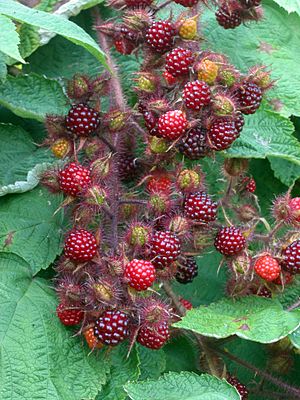Japanese wineberry facts for kids
Quick facts for kids Japanese wineberry |
|
|---|---|
 |
|
| Scientific classification |
The Japanese wineberry (Rubus phoenicolasius) is a type of raspberry plant. It belongs to the rose family and is originally from China, Japan, and Korea.
People brought this plant to Europe and North America. They used it as a pretty ornamental plant or to create new kinds of raspberries. But now, it has spread and grows wild in many places outside of gardens.
How Wineberries Grow
This plant lives for many years. It grows new stems, called 'canes,' every two years from its roots.
In its first year, a new cane (called a 'primocane') grows tall, usually 1 to 3 meters. It does not have branches and has large leaves with three or five smaller parts. These first-year canes usually do not grow any flowers.
In its second year, the cane (now called a 'floricane') stops growing taller. Instead, it grows several side shoots. These shoots have smaller leaves, always with three parts. The bottom of these leaves is white.
The flowers appear in late spring. They grow in small clusters at the tips of the side shoots. Each flower is about 6 to 10 millimeters wide. It has five pink or purplish-red petals and a bristly green cup-like part called a calyx.
The fruit is orange or red and about 1 centimeter wide. It is ready to eat in summer or early autumn. Botanically, it is not a true berry. Instead, it is a group of many tiny fruits called drupelets around a central core. The canes have red, sticky hairs. These red hairs give the plant its scientific name, phoenicolasius, which means red.
As the fruit grows, it is surrounded by a protective calyx. This calyx has hairs that release tiny drops of sticky liquid. Even though it looks a bit like a carnivorous plant, the wineberry does not eat insects. The sticky fluid does not have chemicals to digest insects. Also, the plant grows in soil with plenty of nutrients. So, it does not need to get food from insects.
The plant's leaves and stems are covered in sharp spines. The leaves usually grow in groups of three. The two side leaves are small, and the middle leaf is larger. The top of the leaves is green, and the bottom is white. This white color comes from a thick layer of soft, woolly hairs.
Can You Eat Wineberries?
Wineberries grow wild in many parts of the United States. They are common along the edges of fields and roads. People still use them to create new types of raspberries.
Wineberries are safe to eat. There are no poisonous plants in North America that look exactly like them. Other plants that might be confused with wineberries include red raspberries, salmonberries, black raspberries, and blackberries. All of these are also safe to eat.
Wineberries taste sweet and tart, similar to raspberries. You can use them just like raspberries to make pastries, such as pies or other sweet treats.
Why Wineberries Can Be a Problem
The wineberry plant is originally from eastern Asia. It has been brought to parts of North America and Europe. Wineberries grow very quickly. They can form large, dense patches. These patches can push out many native plant species.
You can find wineberries in many places. These include forests, fields, stream banks, and wet areas. Wineberries grow faster in their first years than many other types of raspberries. They can also carry several viruses. These viruses, like raspberry yellow spot, can harm native raspberry plants.
There are different ways to control wineberry growth. One way is to use biological methods. This means finding ways to make the plants more likely to get diseases. Another way is mechanical control. This involves digging up the plant or cutting it back many times until it dies. You can also use chemicals like glyphosate to kill the plants. This chemical is sprayed on the leaves.
The wineberry is listed as a noxious weed in Connecticut and New York. This means it is against the law to own or sell them in these states.


